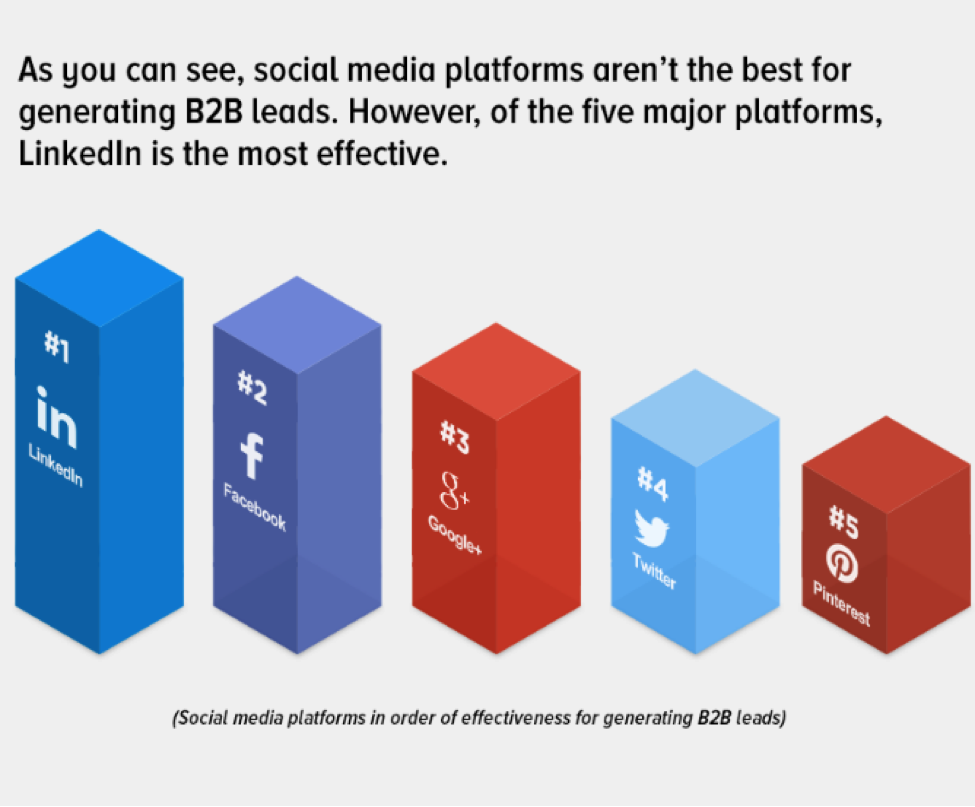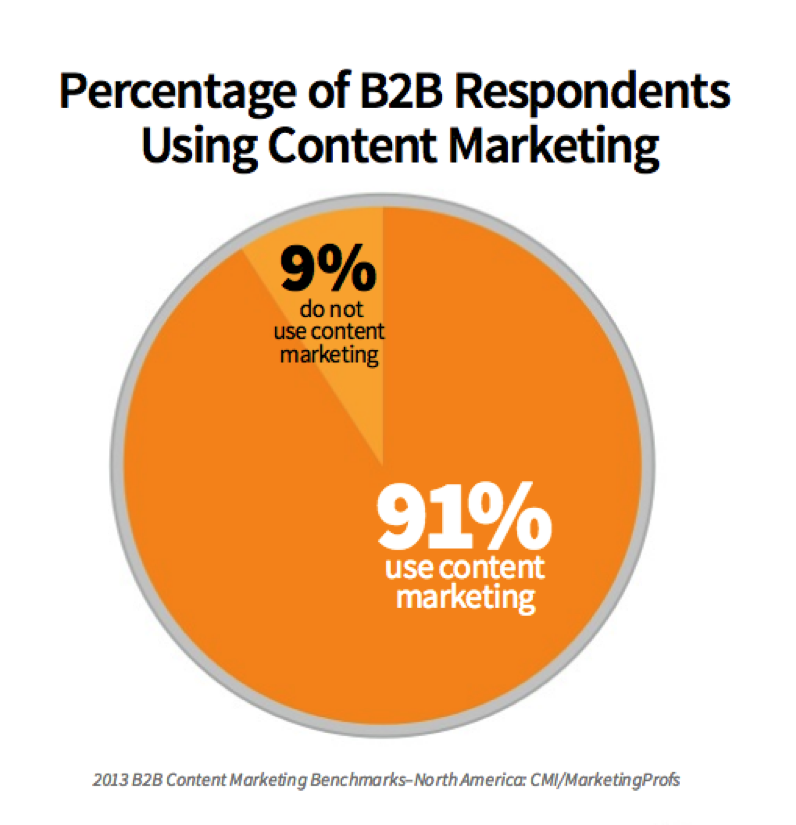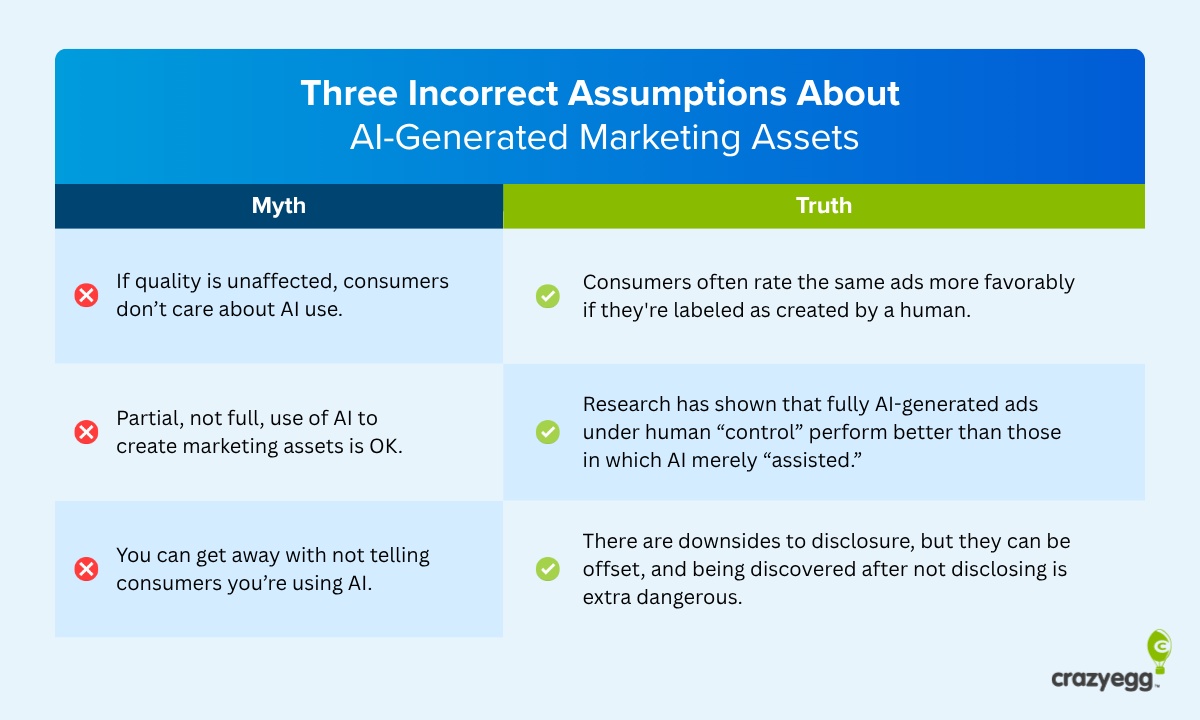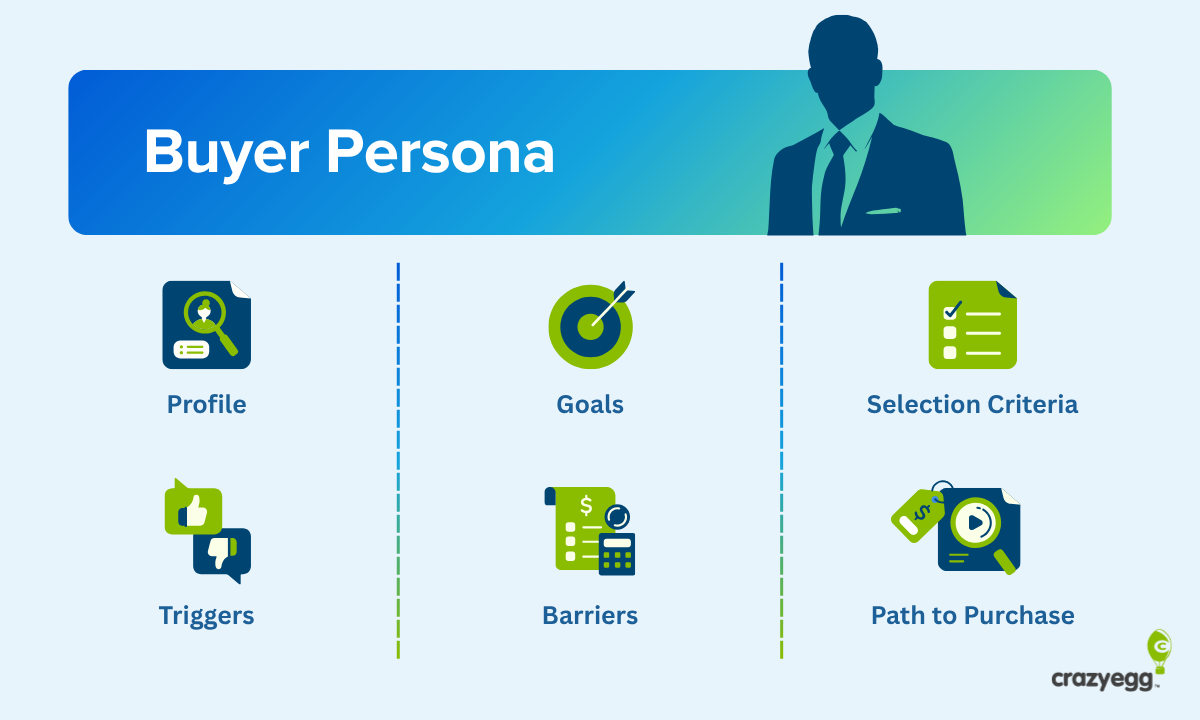Want to know the biggest challenge in B2B marketing? It has nothing to do with what color tie you should wear in a presentation. In one word, it’s leads.
A lead is where it all begins. Without leads, there are no clients, no revenue, no raison d’être. No nothing. Without leads, you’re sunk.
So, the obvious question for any marketer is this: How do I get leads?
 Source: Placeit.net
Source: Placeit.net
All the boring, unsatisfying answers you could ever want
Want to experience nausea? Okay, Google “how to get B2B leads.” You’ll come up with more dreaming drivel than you could imagine.
No one wants to read more pabulum on “Tweet five times a day!” … “Cater to your user’s interest by sharing cat videos on Reddit!” or “Aggressively seek to incrementally maximize your intentional trade show presence for the duration of 2014 in order to garner and nurture more qualified leads.”
Give me a break.
Many B2B marketers are frustrated, ulcer-prone, and occasionally wear mismatched socks precisely because they have one of the planet’s most difficult jobs — getting leads in a swirling maelstrom of misinformation, mistakes, and mystery.
If you’re a corporate marketer with four ulcers, a cracked toenail, thinning hair, and bad dreams about Adwords, I totally understand where you’re coming from. You’re a hero, but you have a tough job.
There’s a bunch of BS out there, which is something that I’m totally not prepared to dish up in this article. I want you to get leads. Real leads. Regardless of your industry.
Two Quick facts about B2B Marketing
Despite the mind-numbing amount of research that I had to do in order to give you this article, I did come across some helpful data. Sure, there was a bunch of glittering generality junk and business jargon gibberish, but there were also some cold, hard facts. Here they are:
No one knows where B2B leads come from.
Hubspot made the chart below to tell us where leads come from. We see all the stuff we’d expect — PPC, social media, advertising, etc. — but there’s also a mysterious spike called “other.” Look at the blue bar on the far right. Hint: It’s the highest bar on the whole graph.
Image from Hubspot.
What the heck is “other”?!
Do you know what that means? It means that we have no freaking clue where B2B leads come from.
Basically, even smart people don’t really know where their leads are coming from all the time. A lot of getting “leads” has to do with a lifestyle of consistent marketing efforts, a constant cultivation of industry relationships, and the organic mashup of all kinds of interactions, activities, behaviors, and efforts.
Voila! There’s a lead! But where did it come from? It’s hard to say.
Takeaway: Rather than focus on a single silver lead bullet, understand that B2B lead generation is a composite of unquantifiable activities and behaviors that just work.
The digital revolution has scrambled the B2B playing field.
This has introduced a flood of new techniques, the decline of old techniques, and a reorganization of all techniques. The goal remains the same — conversions. Where we get those leads for conversions is a totally different game.
Based on the research that I’ve conducted, the tests I’ve performed, the experience I possess, and the strategy I’ve developed, I’ve found four truly successful ways to generate leads, regardless of your industry. Keep reading, and I’ll give you the low down on what you need to know to profit from each of them.
1. Use social media strategically.
Yeah, that was pretty vague, but don’t worry. I’m going to hone in on this for a minute, and explain all.
There are two warnings that I need to issue regarding social media.
- Warning 1: First, don’t expect mere social media presence to be a source of leads. Your social media presence is important, but not inherently effective. I’ll suggest some techniques for using it as a lead generation method. Be warned, however, that it’s not just enough to tweet daily and have an account on LinkedIn.
- Warning 2: Second, don’t dismiss social media as a source of leads. Some individuals have wrongly stated that social media is the holy grail of leads. Don’t go that far. But don’t neglect it, either. Social media is the world’s water cooler. Everyone is there. Everyone is talking. There are leads for the taking. So, as you read this section, be open to the idea of lead generation via social media.
Twitter is not effective.
A Forbes article from 2013 made the bold claim that “Twitter is the strongest social media channel for generating business-to-business (B2B) leads.” The article went on to provide zero proof, except for an oblique reference to a “recent study.”
I’m more interested in facts than I am in someone’s groundless claims.
InsideSales.com discovered that social media was low-effective but high-use in their lead generation technique quadrant:
Image from Insidesales.com
Data compiled by Placester determined that social media had potential, but it was low in relation to other techniques.
There is a reason why social media is clustered at the bottom of the thermometer: People are doing it wrong.
How Social Media Can Work to Generate Leads
Social media is a perfectly fine source of leads. The problem is, the full power of social media is not harnessed in the B2B industry. It’s not that you can’t get leads on social media; it’s that we’re not taking what’s there. Here are some strategic ways to reverse this trend and recapture the leads on social media:
- Direct social media visitors to your website from social media channels. A social media visitor doesn’t constitute a “lead” in the sense of a captured email address or other contact method. For this reason, you need to make sure that the social media visitor goes to your website. Make it easy for them to do so. Provide multiple links to the website, ideally to landing pages that will capture those leads with email signups, free offers, etc.
- Allow newsletter signups on your Facebook page. A great way to gain some leads on social media is to invite newsletter signups directly through the social media channel. In this way, you can gain the email addresses of social media visitors who want your newsletter.
- Use the call to action. Since social media is marketing, it needs to have the occasional CTA. Don’t be afraid to promote your company, invite feedback, link to landing pages, or suggest a next step.
If you apply these three points, you’ll see your leads increase. However, it’s not enough to turn on a veritable flood of leads — just a trickle. There’s another way — the best B2B marketing platform on the Internet.
Use LinkedIn
LinkedIn consistently ranks the highest among social media platforms for its B2B lead generation value. Mediabistro’s visual representation makes this clear:
Image from Mediabistro.com
Research from the Content Marketing Institute and MarketingProfs showed that more B2B marketers use LinkedIn than any other platform.
LinkedIn is a massive gathering of professionals. As the social media big boys go, it’s the biggest and brawniest in terms of the greatest number of professionals, the largest percentage of decision-makers, and the highest per capita income per user.
What’s more, it’s viewed as mature and sophisticated, as opposed to the often-misunderstood nature of Twitter or Google+. Put simply, the kind of businesses that have B2B relationships are more likely to be on LinkedIn.
But again, like the other social media channels, LinkedIn doesn’t generate leads all by itself. Here’s what you need to do to make it work.
- Be present and active. Every social media presence requires that you both have an account and do something about it. Get online, and start being active. Connect with your colleagues and other industry professionals.
- Make sure that your company has a robust LinkedIn account. Now, you need to make sure that your company’s presence is clear. Completely fill out your company’s spot on the network. This is distinct from your own personal profile, and it is essential for B2B leads.
- Join groups. LinkedIn has a huge variety of groups that you can join. You can easily find a group that contains professionals who are likely to become your leads. Here’s my LinkedIn group page. It looks like there are nearly 2 million groups I can join (1,924,327).
- Join conversations. LinkedIn is like a massive cocktail party, minus the cocktails. There are constantly people huddled in groups, talking about everything. Being active in these conversations means being a stronger marketing presence among people who matter.
- Look for help. Sometimes, the best way to encourage a lead is to ask for help. A little quid pro quo goes a long way toward starting and solidifying valuable professional relationships. I’ve used LinkedIn to find qualified people in my industry who can help me with a project, point me in the right direction, or recommend a solution to a quandrum. These people who help me — in or outside of my network — are useful leads.
- Pay for lead collection. If you want to go the direct route, LinkedIn has an integrated lead collection tool.
This tool allows users who come across your company to request a contact. These are genuine warm leads.
Be aware, in order to use the lead collection tool, you must first open an advertising account with LinkedIn, which obviously is going to cost money. Who said that social media leads are free? When the leads come, you’ll get a look at the visitor’s LinkedIn account, and be able to contact the person via LinkedIn or email.
Bottom Line
In spite of the upswing and potential of social media, it hasn’t proven particularly successful for actual high-converting leads. In order to see ROI from these sources, you’ve got to have a process for converting the leads. In order to get the most leads, and get the best leads, you should 1) Use CTAs and links to your website, and 2) Put most of your efforts into Linkedin lead gen.
2. Launch a consistent content marketing plan.
The fact that you’re reading this article right now is proof that I’m a proponent of content marketing. I believe it is the past, future, and present of marketing. It’s not cheap, but it’s effective and it’s been successful for me.
Content marketing is a great source of B2B leads, too. You just have to do it right.
The Growth of Content Marketing for B2B
Content marketing has grown for B2Bs. According to a study sponsored by ContentMarketing and MarketingProfs, 91% of B2B respondents are using content marketing.
Since most companies use an average number of 12 marketing tactics, this indicates a big budgetary push towards content marketing. On average, B2B marketers spend 33% of their marketing budget on content marketing. Cleary, content marketing is big.
Generating Leads through Content Marketing
But how does one actually generate leads through content marketing? Content marketing is a vast field, comprising dozens of subfields. Here are some of the best ways to generate valuable leads through content marketing.
- Host a webinar. Find a topic that will appeal to your marketing segment, and plan a webinar on the topic. Webinars aren’t for selling your product. They are for informing your audience about something that they are already interested in. A webinar is a relatively low-cost way to get your message in front of a huge audience, and to ideally attract a lot of leads.
- Publish research reports. As a researcher, I’m constantly making use of research reports to gain information for my articles. I know how valuable these can be. They are also an incredible source of lead generation. Publishing free research reports is a great way to invite a flood of connections from great leads.
- Videos. There’s no question that videos are the content with the most viral potential and popular appeal. YouTube is, of course, the world’s 2nd largest search engine. If you neglect videos, you are neglecting one of the largest sources of lead-generating content available.
- Blog. Far and away, the best form of content is the blog. A blog, as long as you do it right, is more likely to appear in search results than any other form of content. In order to dominate search engine results, improve your stature in the industry, and gain recognition from those who matter, you need a blog. It’s just that simple.
All of these content marketing techniques work together. For example, you can publish some of the results of a research report on your blog. You can publish a video extract from your webinar. You can announce your webinar on your blog. All of these methods should be used in tandem with one another.
Bottom line
More B2Bs are using content marketing than ever before. It is one of the most effective forms of marketing. The best forms of content are hosting webinars, publishing research reports, producing videos, and keeping a blog.
3. Give away tools.
You should be giving away free stuff. As lead generation goes, it’s a tested and proven method of gaining leads. The concept is simple:
1. Create an ebook that your target market wants.
2. Give it to them for free.
3. They give you their email address.
And then, Voila, you have a lead.
The technique is very popular among B2B marketers, but that doesn’t mean it has lost its appeal. One marketing strategist who uses this method shared his conversion rate for a free ebook. Here’s what he posted on his website. The key metric here is his conversion rate — 10.8%
Image from Source
A 10.8% conversion rate is very good. And, even if the traffic isn’t astronomical, that’s a heck of a lot of leads.
I’ve intentionally recommended that you give away “tools” to keep this point as broad as possible. Let me explain my point a little bit clearer.
Free stuff is basically content marketing.
Like I mentioned above, “content marketing” has legion applications. Providing free stuff is just one of the many iterations of content marketing. I’ve chosen to segment it out as its own point here because it has a distinct edge, and it’s pretty important as B2B lead generation tactics go.
Your free tool should be digital.
The idea behind free tools is that they can be delivered instantly in exchange for an email address. The best option right now is some digital transfer. Besides, email address leads are probably the best type of lead available to the B2B marketer.
Just because your tool is digital doesn’t mean it’s going to be free to you. It will, of course, cost time if nothing else, and it may also require the services of a content writer, programmer, or other contract or in-house professionals.
eBooks are the most popular.
More people are providing free eBooks. Lest the term “eBook” be off putting or overused, some marketers use terms like “guide” or “handbook” or “tips” to describe their offering. Either way, its reading material.
An eBook allows you to directly meet the need of your target audience with a free digital resource. It’s hard to resist. The better your topic, the better your eBook will gain attention from the people who matter most.
There are other options, too.
eBooks aren’t the only digital tool that you can provide. Whatever you choose to give away, make sure it’s directly relevant to the audience to which you’re marketing. Whether its free vector images, royalty-free photographs, beat tracks, WordPress templates, fonts, gifs, or some other widget, make it, promote it, and give it away.
Bottom line
Regardless of your industry, people are willing to get free stuff in exchange for their email address. Use this free technique to harvest huge amounts of email addresses, and let the leads come on in. Directly meet the need of your target audience with a free digital resource
4. Make it automatic.
If you want to sound very intelligent, throw out the term “marketing automation” in your next marketing meeting. (People may just start bowing down to you.)
It’s important to remember that marketing automation isn’t only a lead generation strategy. It’s a comprehensive digital marketing strategy that includes lead generation. Unfortunately, many marketers don’t recognize its lead-gen value, and simply stuff it with bought lists of email addresses, resulting in shoddy and ineffective campaigns.
Marketing automation is a buzzword, but it’s not very well understood. I recommend marketing automation with caution, and primarily to B2B marketers. Here’s what you need to know about it.
What is marketing automation?
Marketing automation uses software to deliver the most relevant content to the most receptive target audience and better enable them to convert. The software used helps to streamline and reduce the time-intensive labor of marketing tasks. The marketer’s role is to tell the software what type of outcome they want.
Marketing automation can gather intelligence to track user behavior on social media or the website and then gain leads. These leads are then nurtured through targeted messages and/or responses. The leads are guided through the marketing funnel using email marketing tactics recommended by the software.
Advanced automated marketing efforts subsume everything in the process from market research to lead gen, to lead management, scoring, nurturing, then transitioning to campaign analysis, qualifying leads, and scoring the effectiveness of sales.
Common questions regarding marketing automation
- How much does it cost? It can be expensive. The price creates enough sticker shock to steer most small companies in another direction. Usually, it’s the big boys with fat marketing budgets that are playing around with marketing automation the most.
- How easy is it? It can be complicated. Because it has the word “automation,” some marketers incorrectly assume that it’s going to be easy. Just buy the software, turn it on, and let it go, right? Wrong. Marketing automation requires complex set-up processes before it can be truly successful.
Bottom Line
I’m recommending marketing automation as a lead generating technique because I believe it can be effective for some B2B companies. Make sure that these features are true of your company before you throw money into marketing automation.
1. Your marketing budget can accommodate a big investment with a period of little to no ROI.
2. Your website is gaining some leads already.
3. Your website traffic is 5k+ unique visitors per month or more.
4. You have a full range of active social media accounts.
5. You have a full-orbed content marketing strategy already in place.
Marketing automation is a growing field, and one that you’re likely going to be faced with in the next year or two. For more information, check out the helpful treatment in MyCustomer.com and SearchEngineLand to help understand and choose the right system.
Conclusion
However you choose to go about your B2B lead generation, it’s always going to be hard work. Keep your strategist head on as you proceed in the effort. If you’re disgusted with boring trade shows, awkward meet-and-greets, and the disappointing results of most B2B lead gen efforts, it’s time to start some new tactics. The four that I’ve discussed above are some of the most effective you’ll encounter, regardless of your industry.
Read other CrazyEgg posts by Jeremy Smith














